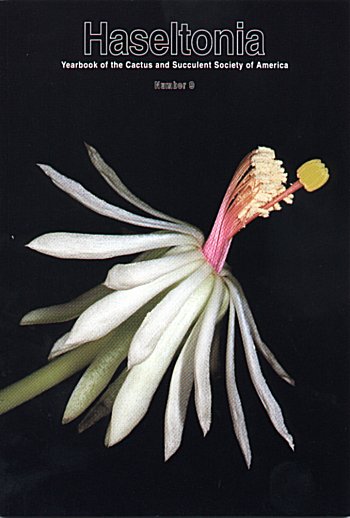| CSSA Haseltonia 9, 2003 |
|---|
| Guest Editorial: Plants, money and research | Charles H. Uhl |
| Epiphyllum baueri Dorsch, a new species from Colombia and Panama | Rudi Dorsch |
| Biological characteristics and nutritive value of aborted flowers of the cardón (Pachycereus pringlei, Cactaceae) in Baja California Sur, Mexico | Jose Luis Léon de la Luz, Reymundo Dominguez-Cadena & Alfonso Medel-Narváez |
| A new species of Aloe on the Ethiopia-Sudan border | Leonard E. Newton |
| Taxonomy, distribution, rarity status and uses of Canadian cacti | J. Hugo Cota-Sánchez |
| The edible Harrisia (Cactaceae) species of the Gran Chaco | Gustavo F. Scarpa & Pastor Arenas |
| Ectotropis N. E. Br. - lost, found, and fragile | Steven Hammer & Tony Dold |
| The utilization of cacti in the upper Rio Bermejo basin, Salta, Argentina | Norma Hilgert & Roberto Kiesling |
| The varieties of Echeveria chiclensis (Crassulaceae), an endemic Peruvian species | Guillermo Pino |
| Studies on Mexican Cactaceae. III. A new hybrid in the genus Opuntia | Héctor M. Hernandez, Carlos Gómez-Hinostrosa & Rolando T. Bárcenas |
| Chromosome numbers and their significance in some Opuntioideae and Cactoideae (Cactaceae) of mainland Ecuador and Peru | Marc A. Baker |
| The typification of Cereus pteranthus Link ex A. Dietr. (Selenicereus pteranthus (Link ex A. Dietr.) Britt. & Rose) | Ralf Bauer |
| Experimental hybridization between Echinomastus intertextus and E. warnockii (Cactaceae) | A. Michael Powell |
| Grusonia pulchella classification and its impacts on the genus Grusonia: morphological and molecular evidence | M. Patrick Griffith |
| The genus Pseudorhipsalis Britton & Rose | Ralf Bauer |
| Chromosomes and hybrids of Echeveria (Crassulacee). VII. Series Gibbiflorae (Baker) Berger | Charles H. Uhl |
| Synopsis of the Cactaceae of Mato Grosso, Brazil | Urs Eggli |
| On the cover: The distinctive flower of Epiphyllum baueri Dorsch, a new species published in this issue. As epiphyllums are rather large and conspicuous plants, new species are now rarely discovered, the last one (E. laui) being published in 1990. E. baueri is distinguished by its reflexed tepals and clustered fascicle of stamens that closely surround the style. Photo: Ralf Bauer. |




